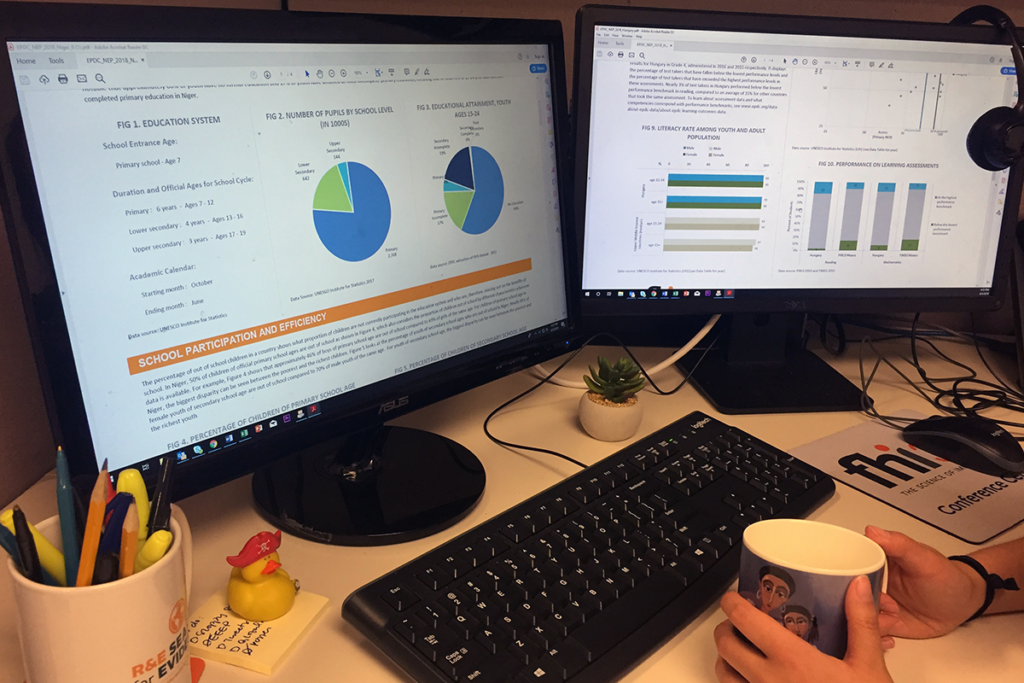A version of this post originally appeared on the Education Policy and Data Center website.
The Education Policy and Data Center (EPDC) has updated its country landing pages with new visuals featuring country-specific education data. These visuals pull live data from the EPDC database to present information on school participation, completion, literacy and educational attainment for any given country. The visuals feature administrative data coming from UNESCO Institute of Statistics, household surveys, and learning assessments. In addition to age and school level, education data is broken by equity dimensions such as gender, urban/rural, and wealth. Below, we have embedded the key visualizations included in the country landing pages, so that users can interact with the data and see what information the visuals can offer for themselves.
EPDC has also updated its National Education Profiles for 129 countries. The profiles present information on education systems, school participation and efficiency, literacy and educational attainment, and education expenditure. View the updated profiles here.
For a snapshot of what the country landing pages have to offer, explore the data available by choosing a country using the drop-down menus below.
Education system
The table below includes information on the structure of the selected country’s education system according to the ISCED classifications. For example, in the Philippines, the official primary school entrance age is six. The system is structured so that the primary school cycle lasts six years, lower secondary lasts three years, and upper secondary lasts one year.
Literacy and educational attainment
The figures below show the highest level of education reached by youth ages 15–24 and the literacy rate among the youth and adult population in the selected country. Although youth in this age group may still be in school and working towards their educational goals, it is notable that in Haiti, for example, approximately 10% of youth have no formal education and 44% of youth have attained at most incomplete primary education – meaning that, in total, 54% of 15–24-year olds have not completed primary education in Haiti. A comparison of youth and adult literacy rates show that the literacy rate is 72% among the youth population, which is higher than the adult population.
School participation and completion
Figures below present data on indicators of net enrollment and completion rates. The first figure looks at net enrollment rates by school level disaggregated by gender (net indicators include only on-time students of official school age) and the second figure shows the average complete rate for primary school children over time.
In Mozambique, for example, the net enrollment rate for primary education is 76% for females and 82% for males. This decreases to a rate of 10% for lower secondary and 2% for upper secondary for both males and females. The completion rate for primary school aged children in Mozambique decreased by almost 10% between 2010 and 2017.
School attendance status
The figure below displays indicators for attendance, showing the different attendance rates for primary school-aged children by wealth group. In this example, we can see girls from poorer households in Pakistan are almost 30% less likely to be attending primary school than those from richer households.
Out-of-school children
The percentage of out of school children in a country shows what proportion of children are not currently participating in the education system who are, therefore, missing out on the benefits of school. The figures below show the percentage of children out-of-school by age and location.
In Honduras, 41% of males aged 13 are out-of-school compared to 36% of females. For males of secondary school age, the percentage of those out-of-school in rural areas is more than double those in urban areas.
Learning
The figures below present the most recent results from national reading and math assessments for the selected country, disaggregated by gender and either grade level or age, whichever is available for that assessment. Both figures display the percentage of test takers that have fallen below the lowest performance levels and the percentage of test takers that have fallen at or above the low performance levels in these assessments.
Results from Cote d’Ivoire, for example, look at performance on the PASEC reading and math assessments for grades 2 and 6, administered in 2014. Only 4% of test takers in grade 6 performed below the lowest performance benchmark in reading, compared to 32% of girls and 25% of boys in math. You can learn more about assessment data and what competencies correspond with performance benchmarks here here.
Our EPDC team is currently working to update the database with indicators covering several key equity dimensions. Stay tuned for the upcoming Inequality pages on EPDC’s website, which will present visualizations of this new data that will allow users to track equity.
Photo credit: FHI 360

